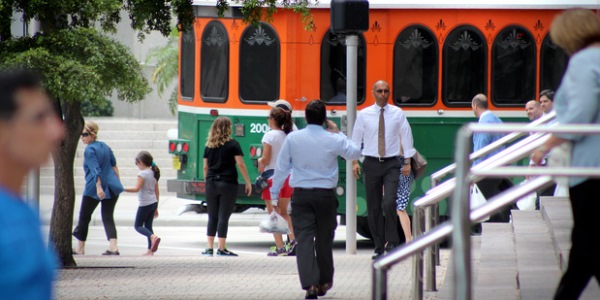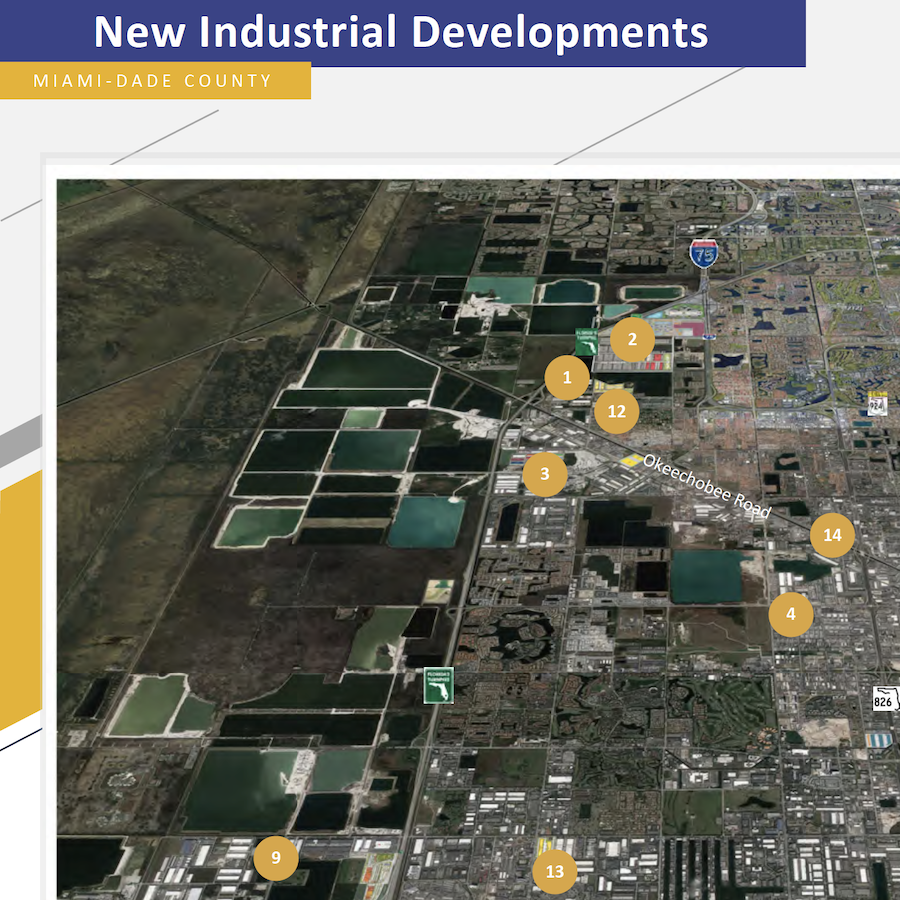
A subtropical mini-Manhattan with glistening steel and glass towers. An outsized “American Dubai,” where foreign zillionaires keep dumping money into ever more outrageous luxury real estate. A flooded wreck overtaken by the unforgiving certainty of sea level rise.
Ask people what the Miami area will look like in the future, and those are some of the more far-out possibilities. Add to those the predictions of Christopher Leinberger, a George Washington University business professor, real estate developer and land use expert for various Washington think tanks. He thinks Miami, against all odds, has the potential to be “walkable.”
Leinberger, president of Locus, a walkable urbanism research organization, has plenty of research behind him. Earlier last month, the group released a report that tabulated market pricing factors to determine which American cities were becoming more urban, dense and walkable—and which were following a pattern of unchecked sprawl.
The report concluded the Miami area was seeing “a fundamental shift from drivable suburban office development to walkable urban.” The report called the finding “surprising and unexpected.”
“The lines have crossed in this real estate cycle,” Leinberger told the Daily Business Review. “Miami is a real man-bites-dog story.”
The research by Leinberger and Patrick Lynch of George Washington’s Center for Real Estate and Urban Analysis found that while Miami ranked 23rd of 30 metropolitan areas in terms of pedestrian-friendly development, the city has the potential to become the fourth most walkable city in the future, close to Washington and New York. The reason is the high premium commanded by office space in denser parts of South Florida compared to suburban office parks.
He pegs the premium driven by Miami office demand at “38 percent and increasing,” Leinberger said. The report found the uptake by tenants in what the report described as South Florida’s 17 “walkable urban spaces”—places like downtown Fort Lauderdale, the Brickell financial district and central South Miami—was lopsided compared to the demand for office space in car-dependent office parks.
“Miami’s walkable urban spaces are absorbing office space at 100 times faster than the region as a whole,” he said. “That’s stunning.”
Downtown Turnaround
Another factor likely to help make South Florida an eminently walkable region is the wide distribution of small but dense urban centers, according to Leinberger. That makes it likely even people who don’t want to live downtown but still want a “gentler, walkable urbanism” will live and work close to smaller urban cores like Aventura or Miami’s Coconut Grove.
“How we’ve seen downtowns in particular turn around is that we see first that retail came and then the urban entertainment scenes, and that picks up for nightlife and people say, ‘I’d like to start renting down here. This is pretty cool.’ And then people start buying. And the people that buy are the kind of people that make the decisions about where to have their business, so it’s a cycle.”
“Of course, it takes time,” Leinberger acknowledged, “Rome wasn’t built in a day.”
Experts in commercial real estate and planning are considerably more skeptical that the Miami metro area is on its way to becoming a pedestrian-friendly region.
“Miami is full of people who are tied to their cars and until you get a cultural mind-set that you can actually use public transit or walk. That’s not changing,” said office broker Elizabeth Santos, vice president of Sime Realty Corp. in Coconut Grove.
As office buildings in Miami’s central business district have increasingly filled coming out of the recession, she said tenants are still demanding significant parking in garages.
“Taking mass transit in Miami is flat-out miserable,” she said, which leads some tenants to pass central locations. “The prospect of going downtown is not attractive, I think, for people of a certain age. I think it’s harder for Baby Boomers and Gen Xers to do it.”
Santos serves on the Board of Directors of the Commercial Industrial Association of South Florida (CIASF).
Public Transit
Similarly, real estate and land use attorney Louis P. Archambault, a partner in the Miami office of Pathman Lewis, said he believes increased development in South Florida’s urban cores “in the short term is going to mean traffic congestion” rather than a move toward more walkable spaces.
As an accident of history, Archambault noted most of South Florida was built after the invention of the automobile, which means it lacks the walkable cores of older cities.
“It’s not fair to be able to expect Miami to have the same kind of infrastructure,” Archambault said. “But once you bring people here and they’re using the PeopleMover on a regular basis and they’re demanding that the service extend longer and that the cars look better, things begin to change.”
“The nice thing about the development you have in downtown Miami is that you now have a lot of people here,” the attorney said. “And once people are here, they start to demand services.”
Archambault acknowledged there are other challenges to overcome but noted “people will find a solution if they’re pushed hard enough. When people do get together and decide they necessarily want this and that’s an important change, the politicians won’t stand in the way.”
Alyce Robertson, executive director of Miami’s Downtown Development Authority, told the DBR, “Because of the development that is going on in the private realm, we also need to catch up on the public side.”
In terms of making South Florida more walkable and reliant on public transit, “the bus rapid transit option is going to be what you see more and more since there’s no support at the federal level or the state level for the huge infrastructure needed otherwise.”
Yet Robinson, whose organization is an autonomous city agency, said government can be part of the solution. She said the DDA is looking at downtown traffic issues as well as “event management.”
Like Leinberger, she agreed the private sector will drive walkability. Projects like downtown’s Centro Lofts, which is being built without a parking garage, Robinson said.
“They wouldn’t go into the ground with a project like Centro if there was no demand,” she said. “The developers wouldn’t be building it if there weren’t a market to sell it to.”
Source: DBR























